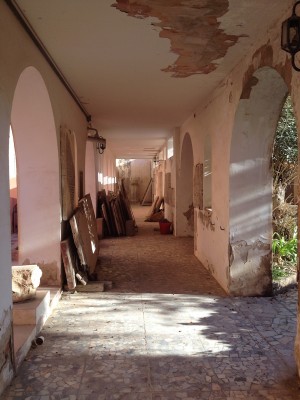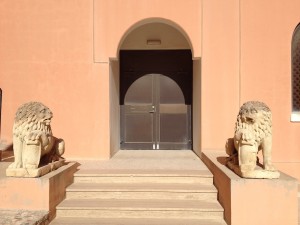Libya herald
A new architectural book setting out a range of proposals and guidelines for the conservation and restoration of Tripoli’s Red Castle could boost the future of one of the capital’s most important buildings.
Il Castello Rosso di Tripoli: Un’esperienza di ricerca per un intervento di conservazione - the culmination of years of research – was presented to the Department of Antiquities at a Tripoli conference last week.
“It is a preliminary work, to allow Libyans to make decisions about the future of the building,” author and a Professor at Italy’s University of Urbino, Laura Baratin, told the Libya Herald. “It shows different guidelines and paths that could be followed, all of which conform to international standards.”
Parts of the landmark building, which is home to Tripoli Museum as well as many valuable Libyan archives, date back to the seventh century. Successive structural additions, as well as neglect and multiple uses, have left the building in a vulnerable condition.
 The Red Castle has problems with humidity, water ingress and rising
damp, Baratin explained. An added difficulty is the different materials
used in both the original construction and subsequent building work.
Numerous interventions and additions to the original structure also
needed to be taken into account in the research, she said.
The Red Castle has problems with humidity, water ingress and rising
damp, Baratin explained. An added difficulty is the different materials
used in both the original construction and subsequent building work.
Numerous interventions and additions to the original structure also
needed to be taken into account in the research, she said.
Its proximity to Martyrs’ Square and its current functions, including housing many important historic artefacts in the museum, were also considered when putting forward potential guidelines for future conservation and use. The Red Castle was both a monument and a functional space, Baratni explained, which added another dimension to the research.
“The Red Castle is not a small or easy project but the important thing about this work is that it is a big first step so the Department of Antiquities does not have to start from scratch,” Baratin said.
The research has taken years to complete, with most work undertaken between 2005 and 2009. It involved an in-depth survey of the whole building, including the urban complex within the walls, as well as chemical and technical analysis of building materials. This informed suggestions for how best to proceed with conserving it, Baratin said.
“It was a useful event and we consider the book as a next step for us to put plans together to preserve this castle,” Adel Al-Turki from the Department of Antiquities said. “My feeling is that we first need to have a view regarding the future use of the castle, whether it will be a place for tourists or whether we will continue to use it for various purposes, including some offices.”
Turki added that establishing a future plan for the castle was the priority. “It is difficult to make decisions about the conservation of the building without knowing what it will be in the future,” he said.
Baratin said she was delighted by the many questions that followed the presentation of the work, which showed how interested and committed Libyans were to preserving the building.
Rubens Piovano – the Director of the Italian Institute in Tripoli which organised the conference, described as one of the most important pieces of Libya’s heritage. “When you say Tripoli, people think of the Red Castle,” he said.
Several initial copies of the work were presented on Thursday, but two hundred more have been printed and will be delivered to the Department of Antiquities.
Baratin said she hoped work would start quickly on the Red Castle. “Stability and security problems are holding progress back, but Libya needs to invest more in this project,” she said.
Baratin pointed out that Europe should also commit itself to helping conserve the building. “It belongs not just to Libya, but to humanity, especially as Tripoli is the gateway to Libya.”
The project was funded by the Italian Ministry of Foreign Affairs, in collaboration with the Libyan Department of Antiquities, which falls under the Ministry of Culture. The book presentation event was organised by the Italian Cultural Institute in Tripoli.
A new architectural book setting out a range of proposals and guidelines for the conservation and restoration of Tripoli’s Red Castle could boost the future of one of the capital’s most important buildings.
Il Castello Rosso di Tripoli: Un’esperienza di ricerca per un intervento di conservazione - the culmination of years of research – was presented to the Department of Antiquities at a Tripoli conference last week.
“It is a preliminary work, to allow Libyans to make decisions about the future of the building,” author and a Professor at Italy’s University of Urbino, Laura Baratin, told the Libya Herald. “It shows different guidelines and paths that could be followed, all of which conform to international standards.”
Parts of the landmark building, which is home to Tripoli Museum as well as many valuable Libyan archives, date back to the seventh century. Successive structural additions, as well as neglect and multiple uses, have left the building in a vulnerable condition.

Parts of the castle have been neglected and are in urgent need of conservation (Photo: Tom Westcott)
Its proximity to Martyrs’ Square and its current functions, including housing many important historic artefacts in the museum, were also considered when putting forward potential guidelines for future conservation and use. The Red Castle was both a monument and a functional space, Baratni explained, which added another dimension to the research.
“The Red Castle is not a small or easy project but the important thing about this work is that it is a big first step so the Department of Antiquities does not have to start from scratch,” Baratin said.
The research has taken years to complete, with most work undertaken between 2005 and 2009. It involved an in-depth survey of the whole building, including the urban complex within the walls, as well as chemical and technical analysis of building materials. This informed suggestions for how best to proceed with conserving it, Baratin said.
“It was a useful event and we consider the book as a next step for us to put plans together to preserve this castle,” Adel Al-Turki from the Department of Antiquities said. “My feeling is that we first need to have a view regarding the future use of the castle, whether it will be a place for tourists or whether we will continue to use it for various purposes, including some offices.”
Turki added that establishing a future plan for the castle was the priority. “It is difficult to make decisions about the conservation of the building without knowing what it will be in the future,” he said.
Baratin said she was delighted by the many questions that followed the presentation of the work, which showed how interested and committed Libyans were to preserving the building.
Rubens Piovano – the Director of the Italian Institute in Tripoli which organised the conference, described as one of the most important pieces of Libya’s heritage. “When you say Tripoli, people think of the Red Castle,” he said.
Several initial copies of the work were presented on Thursday, but two hundred more have been printed and will be delivered to the Department of Antiquities.
Baratin said she hoped work would start quickly on the Red Castle. “Stability and security problems are holding progress back, but Libya needs to invest more in this project,” she said.
Baratin pointed out that Europe should also commit itself to helping conserve the building. “It belongs not just to Libya, but to humanity, especially as Tripoli is the gateway to Libya.”
The project was funded by the Italian Ministry of Foreign Affairs, in collaboration with the Libyan Department of Antiquities, which falls under the Ministry of Culture. The book presentation event was organised by the Italian Cultural Institute in Tripoli.

ليست هناك تعليقات:
إرسال تعليق